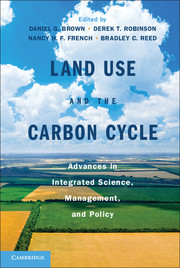Book contents
- Frontmatter
- Contents
- Chapter Authors and Affiliations
- Acknowledgments
- Acronyms
- Part I Introduction
- Part II Measurement and Modeling
- Part III Integrated Science and Research Applications
- Part IV Land Policy, Management, and the Carbon Cycle
- 13 Managing Carbon: Ecological Limits and Constraints
- 14 Effects of Wildland Fire Management on Forest Carbon Stores
- 15 Soil Carbon Dynamics in Agricultural Systems
- 16 U.S. Policies and Greenhouse Gas Mitigation in Agriculture
- 17 Opportunities and Challenges for Offsetting Greenhouse Gas Emissions with Forests
- 18 Opportunities and Challenges for Carbon Management on U.S. Public Lands
- 19 Design and Planning of Residential Landscapes to Manage the Carbon Cycle: Invention and Variation in Land Use and Land Cover
- Part V Synthesis and Future Directions
- Index
- Plate Section
- References
15 - Soil Carbon Dynamics in Agricultural Systems
Published online by Cambridge University Press: 05 February 2013
- Frontmatter
- Contents
- Chapter Authors and Affiliations
- Acknowledgments
- Acronyms
- Part I Introduction
- Part II Measurement and Modeling
- Part III Integrated Science and Research Applications
- Part IV Land Policy, Management, and the Carbon Cycle
- 13 Managing Carbon: Ecological Limits and Constraints
- 14 Effects of Wildland Fire Management on Forest Carbon Stores
- 15 Soil Carbon Dynamics in Agricultural Systems
- 16 U.S. Policies and Greenhouse Gas Mitigation in Agriculture
- 17 Opportunities and Challenges for Offsetting Greenhouse Gas Emissions with Forests
- 18 Opportunities and Challenges for Carbon Management on U.S. Public Lands
- 19 Design and Planning of Residential Landscapes to Manage the Carbon Cycle: Invention and Variation in Land Use and Land Cover
- Part V Synthesis and Future Directions
- Index
- Plate Section
- References
Summary
Introduction
The soil carbon (C) pool constitutes the largest reservoir of C in terrestrial ecosystems, containing 2450 Pg total C, 1500 Pg as soil organic carbon (SOC) and 950 Pg as soil inorganic carbon (SIC) (Lal 2004a; Houghton 2007; Morgan et al. 2010) in the top 1 meter of soil with an additional ~894 Pg total C found between 1 and 3 meters depth (Chapter 2, this volume). There is a strong link between atmospheric CO2 and SOC that is facilitated by C transfer through the terrestrial biotic pool (Lal 2004b). Approximately 60 Pg of atmospheric C is transferred to terrestrial ecosystems annually through the process of photosynthesis and an equivalent amount returned back to the atmosphere through soil and root respiration. (Lal 2004b; Morgan et al. 2010). Currently atmospheric carbon dioxide content is increasing at the rate of ~4.1 Pg C yr–1 (IPCC 2007) and a small fraction is estimated to come directly from agricultural activity (Lal 2007; Morgan et al. 2010). Full accounting of C emissions and sequestration to obtain net C flux budgets for agriculture indicate that agricultural land can function as a net source or sink of C (McLauchlan 2006), depending on land use and management.
Adoption of land-management strategies that foster carbon (C) sequestration in agricultural soils will be important over the next several decades as new mitigation strategies and technologies are developed to reduce C emissions (Smith 2004). Agricultural land-management options currently recommended to foster C sequestration nearly always include some reduction in tillage intensity and implementation of integrated, multifunctional cropping rotations that include forage legumes, small grains, and organic amendments from animal manure or compost, supporting the production of primary commodity crops (e.g., corn, soybean, wheat, rice, and cotton).
- Type
- Chapter
- Information
- Land Use and the Carbon CycleAdvances in Integrated Science, Management, and Policy, pp. 381 - 402Publisher: Cambridge University PressPrint publication year: 2013
References
- 1
- Cited by



